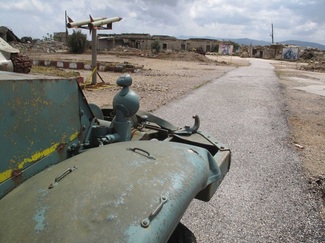
Situated on a hill overlooking the town of Khiam and about 15 kilometers from Hasbaya, the Khiam Detention Center was built as a French barrack complex in the 1930s. It became a base for the Lebanese army before falling under the control of the SLA (South Lebanon Army). In 1985, during the Israeli occupation of the south of Lebanon, the compound succeeded the Ansar detention camp and became the site where over 5,000 Lebanese supporters and fighters of the resistance against Israel were imprisoned under appalling conditions and often tortured by the SLA. In May 2000, when Israeli troops withdrew from Lebanon, the SLA abandoned the detention center, allowing local civilians to set free the remaining 145 detainees. Soon after this, the detention center became an informal tourist attraction. A volunteer committee of former detainees, supported by Hezbollah, maintained and controlled the site with the aim to inform visitors about its role during the Israeli occupation and narrate the experiences of the detainees.
In July 2006, the detention center, along with much of the town of Khiam, was effectively destroyed by an Israeli bombardment. Since then, several plans have been created for reconstruction and reopening of the center as a formal tourist site. Even though none of these plans have yet been materialized, a visit to this wreckage of the former prisons, still surrounded by tanks and rocket launchers, is impressive and worth a detour. The prison is located just outside the village of Khiam.
To reach Khiam from Saida, first head in the direction of Nabatiyeh. Once in Nabatiyeh, keep left at the roundabout toward Kfar Roumanna and continue straight until after about 10 minutes you reach a roundabout. There, keep right and after about 1.5 kilometer, take a right road down. At the end of this road, turn left onto the main road. From there, continue first toward Chebaa and then Khiam. Once in Khiam, the prison is clearly signposted as Prison or Prison el Khiam. Duration: about 1.75 hrs.
A visit to the prison is free of charge and will take between 30 and 45 minutes.

